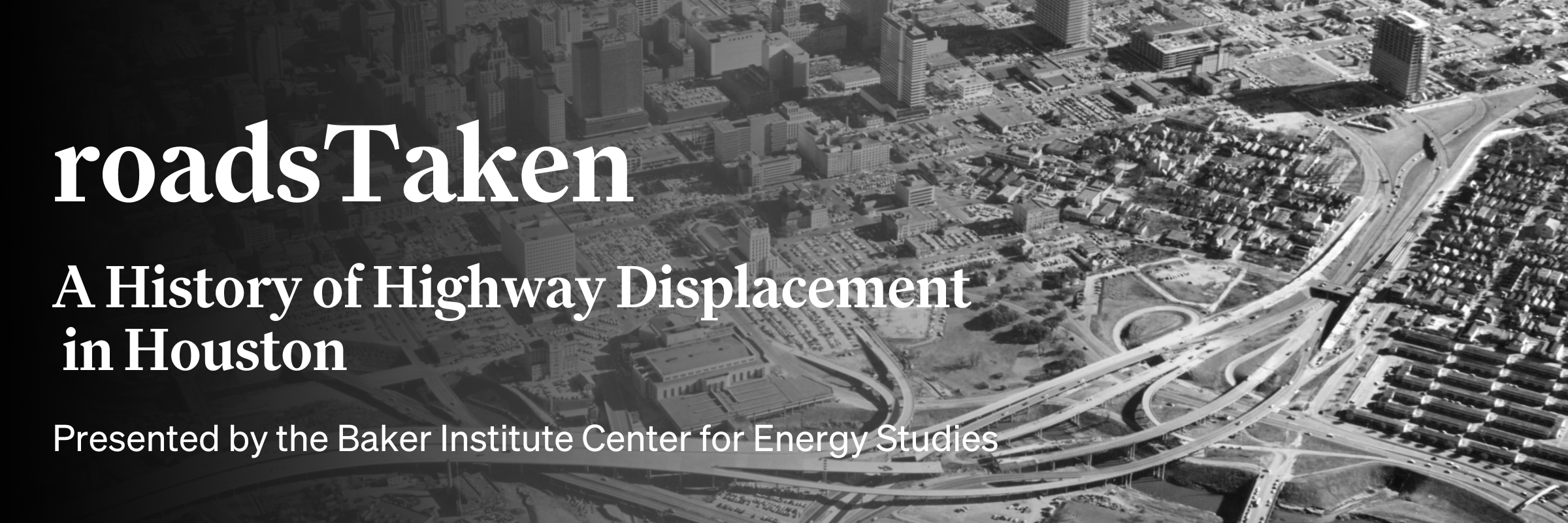
About roadsTaken
Related Research
Houston’s Freeways: Who Was Displaced and Why?
Some scholars claim freeways were designed to adversely impact neighborhoods of color. This oversimplifies the issue, writes Ed Emmett. This research paper explores the history of Houston’s freeways to uncover a range of factors at play.
Contributing Experts
Sources & Acknowledgements
“Digital Sanborn Maps, 1867–1970. Texas.” Bell & Howell Information and Learning, 2001.
Morrison & Fourmy’s Greater Houston (Texas) City Directory. Morrison & Fourmy Directory Co., 1940–57.
Perry-Castañeda Library Map Collection. “Sanborn Fire Insurance Maps — Texas.” Courtesy of the University of Texas Libraries, The University of Texas at Austin.
Polk’s Houston (Harris County, Texas) City Directory. Polk, 1958–73.
“Real Property Asset Map.” Texas Department of Transportation, Right of Way Division, Surveying Section. https://maps.dot.state.tx.us/AGO_Template/TxDOT_Viewer.
Sanborn Map Company. “Sanborn Fire Insurance Maps: Houston, Harris, Texas, Volumes 1–16.” Courtesy of the Local History Collection, Houston History Research Center, Houston Public Library.
Social Explorer Tables, Census 1940 Census Tract Only. Digitally transcribed by Inter-university Consortium for Political and Social Research. Edited, verified by Michael Haines. Compiled, edited, verified, and additional data entered by Social Explorer.
Social Explorer Tables, Census 1950 Census Tract Only. Digitally transcribed by Inter-university Consortium for Political and Social Research. Edited, verified by Michael Haines. Compiled, edited, verified, and additional data entered by Social Explorer.
Social Explorer &; U.S. Census Bureau — DUALabs. Total Population, Race, Housing Units, and Tenure, 1960. Prepared by Social Explorer.
Social Explorer &; U.S. Census Bureau. Total Population, Race, Housing Units, and Tenure, 1970. Prepared by Social Explorer.
Texas Highway Department. “Plans of Proposed Right of Way.” Courtesy of the Texas Department of Transportation, Houston District.
United States Census Bureau.1940 US Census, Harris County, Population Schedules. https://catalog.archives.gov/id/16660414.
United States Census Bureau.1950 US Census, Harris County, Population Schedules. 1950census.archives.gov.
The project could not have been conceived and completed without the leadership of Ed Emmett and the Baker Institute Center for Energy Studies and the support of Farès el-Dahdah and Diluvial Houston. Recognition also goes to the leadership and research staff of the Center for Energy Studies — Ken Medlock, Miaomiao Rimmer, Elsie Hung, Christene Kimmel, Melissa Vossler, and Julie Cohn — for their advice, feedback, and support, and to the developers and designers at the Spatial Studies Lab at Rice University’s Center for Research Computing — specifically Ualas Barreto Rohrer, who built the web architecture for the project.
We also extend our sincere appreciation to the dedicated and knowledgeable archivists at the following institutions: the Woodson Research Center at Rice University’s Fondren Library, MD Anderson Library Special Collections at the University of Houston, the Houston Public Library’s Houston History Research Center and African American History Research Center at The Gregory School, Harris County Archives, the Dolph Briscoe Center for American History at the University of Texas at Austin, and the Texas State Library and Archives. Without their efforts, this project and so many like it would be impossible. Thank you to Jennifer Unruh, Ginger Berni, and the other staff at Houston History Research Center for their many hours answering questions, digitizing maps, and pulling sources. Thank you to Rick Henderson, Thien Nguyen, and Anne L. Cook for their help in obtaining right-of-way planning maps and for sharing photographs of highway construction. The Houston Planning and Development Department generously gave their time, expertise, and resources and allowed us to explore their extensive collection of maps, records, and files. Thank you to their dedicated team of public servants: John Cox, Veronica Davis, Peter Eccles, David Fields, Angelita Pineda, Roman McAllen, Dipti Mathur, and Kevin Shuff.
Thank you also goes to the community of scholars and experts who provided useful guidance and feedback during the planning and execution of this project: Karen Benjamin, W. Caleb McDaniel, Josiah Rector, Brian Riedel, Kyle Shelton, and Jerry Wood. In addition, Tara Drwenski at the University Corporation for Atmospheric Research provided hours of programming and coding expertise; Maya Reine and Portia D. Hopkins organized the Black Houston(s) Symposium at Rice University and the American History Research Center at The Gregory School, which was formative for this and future work; and Erik Slotboom provided an important and valuable history in “Houston Freeways: A Historical and Visual Journey” (Oscar F. Slotboom, 2003).
Several brilliant and dedicated student interns helped construct the core of this database and map: Ben Baker-Katz, Hyeyoung Doh, Josué Alvarenga, Samuel Lee, and Indrani Maitra. Ben Baker-Katz has been involved since the earliest stages of the project and his insights were invaluable. He mapped and cataloged parts of the Fourth and Third wards and georeferenced many of the historical photographs in the database. Hyeyoung Doh mapped the South Freeway structures and researched Riverside Terrace. Josué Alvarenga mapped the Katy and East freeways and researched Lyons Avenue. Samuel Lee mapped Houston’s Inner Loop Freeway and researched Independence Heights. Indrani Maitra mapped the Eastex Freeway and researched Frenchtown. Finally, thank you to Fondren Library’s Fondren Fellows program and the Baker Institute Center for Energy Studies, which provided the funding for this research and stipends for these amazing young scholars.












